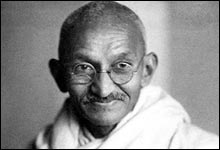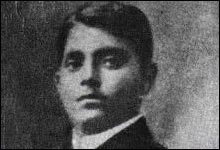GREAT INDIAN PERSONALITIES : Netaji Subhas Chandra Bose

According to historians, the war of Indian Independence started with the Sepoy Mutiny of 1857. From then, our motherland was soaked with the blood of the martyrs and the tears of their weeping families. There was unrest and terror unleashed at every corner. Amidst these stood the erect figures of those who dared to raise their voice or take up action against the foreign invaders.
Subhas Chandra Bose stood tallest among all who put up a fight until death against the British. Bose was born in Cuttack, Orissa, on January 23rd, 1897 of Janakinath Bose and Probhabati Debi. He completed his formal education at Ravenshaw Collegiate School where he was greatly inspired by his teacher, Benimadhab Das. Later he moved on to Calcutta to complete his graduation from Presidency College. Here he was included in a controversy of assaulting a professor, Mr. Oaten who was inclined towards apartheid and insulted Indian students.
Bose was found guilty as the prime mover behind the assault and was rusticated in 1916. Sir Asutosh came to his rescue and he was admitted under him in the Scottish Church College in 1917 from where he graduated in philosophy in 1919. In the meantime he had trained himself in university training corps( U.T.C.). In 1920 he went to England for the I.C.S. examination and was admitted in Cambridge and secured the 4th place. Bose did not complete the probation period as he was disturbed by the barbaric British attitude as evident from the Jalianwala Bag massacre.
Netaji Subhas Chandra Bose resigned from I.C.S in 1921 and came back to Calcutta leaving behind a lucrative opportunity of a lifetime. Netaji Subhas Chandra Bose teamed with C.R.Das and became an ardent nationalist. He was immediately arrested and was imprisoned for 3 years in Mandalay prison, Burma, on false charges. In 1927 he was released on medical grounds. In the same year, he was elected the president of Bengal Prodesh Congress Committee. He set up the Independence League but was again jailed during the Salt Satyagraha. Netaji Subhas Chandra Bose was released after the Gandhi- Irwin Pact but he protested against the pact and was detained again and was banished to Europe. Here he came across Emily Shenkel, whom he appointed his secretary and later married. He returned to India defying the ban in1936 and was jailed again. Netaji Subhas Chandra Bose was freed in 1937 and after the general election he was elected the president of I.N.C in1938 in its Haripura session. However, differences with the Gandhi led to his resignation in April 1939. Netaji Subhas Chandra Bose formed the National political Party in the name of Forward Bloc. When India was dragged into the 2nd World War, Forward Block launched a massive movement on April 6th 1940. On July 1940, he was jailed again and he started hunger strike. He was released but was placed under house arrest. On 26th Jan 1941, disguised as Maulavi Sahib the insurance agent, Bose fled from his home in a car driven by Sisir Bose. He reached Peshwar and changed his guise as the deaf and dumb Ziauddin and started for Kabul. With the help of The Italian Embassy at Kabul, he obtained an Italian diplomatic passport under the name Orlando Mazzota and started for Germany thorough Russia. Netaji Subhas Chandra Bose met Hitler but his hopes were not fulfilled. From Jan 1942, he began regular broadcasts from Radio Berlin against the British.

On July 1943, Netaji Subhas Chandra Bose arrived In Singapore and two days later took over from Rashbehari Bose the leadership of the Azad Hind Fouz or Indian National Army. He became its supreme commander on August 25th and proclaimed the provisional government of Azad Hind on Oct 21st. Andaman and Nicobar islands were occupied by the INA. In March 1944, INA Marched into Indian soil, ie Kohima in Nagaland and also in Imphal in Manipur.
In 1944, the INA shifted its base to Rangoon. But in a few days , the atom bomb was dropped and Japan surrendered and INA had to retreat. He was said to have died in an air crash over Taipei on August 18th 1945 but no firm evidence could be provided. Bose was a warrior who had dedicated his life for the sake of his motherland. Netaji Subhas Chandra Bose is still acclaimed as the brightest star Bengal ever produced.


